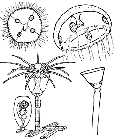
| Introduction | | Search taxa | | Taxon tree | | Taxon match | | Checklist | | Literature | | Stats | | Photogallery | | OBIS Vocab | | Log in |
WoRMS taxon detailsCampanulariidae Johnston, 1836
1606 (urn:lsid:marinespecies.org:taxname:1606)
accepted
Family
Eucopidae Gegenbaur, 1857 · unaccepted (synonym)
Obelidae Haeckel, 1879 · unaccepted (synonym)
Obelinae Haeckel, 1879 · unaccepted > junior subjective synonym
Orthopyxinae Russell, 1953 · unaccepted (synonym)
marine,
Johnston, G. (1836). A catalogue of the zoophytes of Berwickshire. <em>Hist. Berwicksh. Nat. Cl.</em> 1 : 107- 108., available online at http://www.biodiversitylibrary.org/item/15570#119
page(s): 107 [details]
Schuchert, P. (2024). World Hydrozoa Database. Campanulariidae Johnston, 1836. Accessed through: World Register of Marine Species at: https://www.marinespecies.org/aphia.php?p=taxdetails&id=1606 on 2024-09-23
Date action by 2004-12-21 15:54:05Z created db_admin
original description
Johnston, G. (1836). A catalogue of the zoophytes of Berwickshire. <em>Hist. Berwicksh. Nat. Cl.</em> 1 : 107- 108., available online at http://www.biodiversitylibrary.org/item/15570#119
page(s): 107 [details] original description (of Eucopidae Gegenbaur, 1857) Gegenbaur, C. (1857). Versuch eines Systems der Medusen, mit Beschreibung neuer oder wenig gekannter Formen; zugleich ein Beitrag zur Kenntnis der Fauna des Mittelmeeres. <em>Zeitschrift für wissenschaftliche Zoologie.</em> Leipzig 8: 202-273, pls 7-9., available online at https://www.biodiversitylibrary.org/page/13864647 page(s): 241 [details] original description (of Obelidae Haeckel, 1879) Haeckel, E. (1879). Das System der Medusen. Erster Teil einer Monographie der Medusen. <em>Denkschriften der Medicinisch-Naturwissenschaftlichen Gesellschaft zu Jena.</em> 1: XX+1-360, 320 plates., available online at https://www.biodiversitylibrary.org/page/32605578 page(s): 163 [details] basis of record Bouillon, J.; Boero, F. (2000). Synopsis of the families and genera of the Hydromedusae of the world, with a list of the worldwide species. <i>Thalassia Salent. 24</i>: 47-296 (look up in IMIS) [details] additional source Cornelius, P.F.S., 1982. Hydroids and medusae of the family Campanulariidae recorded from the eastern North Atlantic, with a world synopsis of genera. Bull. Br. Mus. nat. Hist., Zool. 42 2: 37-148. [details]  Present Present  Inaccurate Inaccurate  Introduced: alien Introduced: alien  Containing type locality Containing type locality
From editor or global species database
Diagnosis Hydroid colony stolonal or erect, branching; hydrothecae bell- or cup-shaped, radially symmetrical, sometimes secondarily bilateral symmetric, pedicellate, with basal diaphragm or inward annular thickening of perisarc; hydranth generally tubular, with flared or globose hypostome with a pregastric cavity; gonophores in gonothecae, developing into free medusae, eumedusoids or sporosacs.Medusa with short manubrium, no gastric peduncle, four radial canals (exceptionally more); with or without velum (Obelia); gonads surrounding radial canals, separated from manubrium; with or without rudimentary bulbs; no cirri, excretory papillae or pores; eight and more closed statocysts; no ocelli. [details] Spelling Nama introduced as Campanulariadae by Johnston (1836), which is the modern equivalent of Campanulariidae. [details]
|

